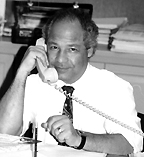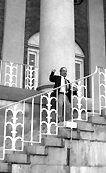 |
|
Lance
Liotta, |
The guest editorial this issue is from Lance Liotta, who launched The NIH Catalyst in 1993, during his tenure as deputy director for intramural research in the time of Bernadine Healy’s NIH directorship. It is only fitting, then, that the departing remarks he delivered at his going-away party at the Cloisters May 11 be adapted to fill this issue’s DDIR column.
A typical statement by the departing person at a going-away party is that this job has been the best years of their career. I cannot make that statement . . . . this has been the only job I have had since medical school. I joined the Laboratory of Pathology as a resident in 1976, and because I loved this place so much, and loved the people so much, I stayed ever since.
Over the last three decades, I’ve learned much from my role models—my co-workers, residents, students, and colleagues. Here are some of the important principles.
Principle 1: It is not enough to believe in a dream. There must be someone who believes in the dreamer. In the beginning of my career, my family and Dr. [Alan] Rabson believed in me—so I began to believe in myself and had the courage to take risks. In 1997, I was privileged to meet Chip Petricoin, and together we proposed our dream of proteomics to NCI. The institute appreciated our dream and helped us create a new clinical proteomics program.
Principle 2: The best way to see your dream realized is to give it away. Transfer the dream to other team members and trainees; let them internalize it, improve on it, and call it their own. This is the secret to germinating a large number of ideas in one’s short lifetime.
Principle 3: Taking a risk is the best way to gain security in science. Instead of choosing the popular, safe topic that is in vogue, but will soon be out of vogue, it is smarter to get into new territory, explore beyond the campsite, and discover your own promised land. After all, we really know less than 1 percent about how biology works.
Principle 4: Hire people who are smarter than you and then get out of their way—but continue to lurk in the background and shield them from problems that might distract them. I have been fortunate to work with world-famous pathologists.
 |
 |
 |
Principle 5: Strive to be taken for granted. The best administrative support is invisible. The Laboratory of Pathology has been fortunate to have tireless champions working behind the scenes for its scientific staff–handling the myriad complex personnel activities that come with the territory of the largest lab/branch at NIH and training hundreds of collaborators in the art of laser-capture microdissection and proteomics tecnology.
Principle 6: Publications and patents are not the best way to extend science into the future. The best way is to train and inspire the future scientific leaders and teach them to make your theories and technology obsolete. Our lab’s summer student program has literally changed the lives of hundreds of former students who are now physicians and scientists.
* * * * * * * *
When I arrived here as a resident, I viewed the intramural NIH with the deepest reverence—and I still feel the same way. This place has truly been a scientific utopia driven by creative opportunity and freedom, all directed toward the goal of public health benefit. Here, each day, you can wake up to pursue a new idea, try out the idea, and let the data drive the science. Here you have the greatest opportunity to take risks and test grand paradigms. Take advantage of that opportunity and privilege, as I have.
George Gershwin was asked, "What comes first, the music or the lyrics?" "The money," he answered, referring to the funding from his patrons. In this time of serious NIH fiscal restrictions, many have expressed concern that the music of science will be silenced. I am an eternal optimist. Even if we, as scientists, have to do more with less, a bold creative idea is still the best means to gain funding and move the science to help patients. Do everything to protect that freedom.
 |
Professor of Life Sciences and Co-Director
Center for Applied Proteomics
and Molecular Medicine
George Mason University
College of Arts and Sciences
Fairfax, Virginia